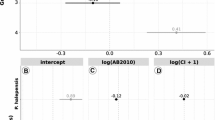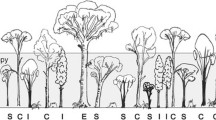Abstract
The growth dynamics and mode of competition between adult trees ≥ 5.0cm in diameter at breast height (DBH) of nine abundant treespeciesoccupying ca. 85% of the total basal area were investigated in a 4ha study plot (200 m × 200 m) of awarm-temperate old-growth evergreen broad-leaved forest in the Tatera ForestReserve of Tsushima Island, southwestern Japan. In the plot, adult trees ≥5.0 cm DBH co-occurred with 35 woody plant species (except forwoody vine species). The most dominant and largest species,Castanopsis cuspidata var. sieboldiiexhibited a bimodal DBH distribution; it was found in both the upper and lowervertical layers. Other tree species had unimodal DBH distributionscorrespondingmostly to the lower vertical layer. We developed a model for individual growthincorporating both intra- and interspecific competition and degree ofcompetitive asymmetry. One-sided interspecific competition was detected in 17cases out of the 66 possible combinations on the scale of the 4 hastudy plot. The direction of interspecific competition was generally one-sidedfrom layer-I species to layer-II and III ones. The effects of two-sidedcompetition were detected only in layer-II and III species. OnlyDistylium racemosum exhibited one-sided intraspecificcompetition. We also found 11 cases of positive interspecific relationships.Generally, competitive relationships prevailed over positive relationshipsbetween adult trees in this warm-temperate evergreen broad-leaved forest.Competition between adult trees ≥ 5.0 cm in DBH did not occurinthe same vertical layer, but occurred only between trees in different verticallayers. This suggests that competition between adult trees ≥ 5.0cm in DBH plays a key role in the variation in species coexistencebetween different vertical layers on the 4 ha scale of thewarm-temperate evergreen broad-leaved forests. Moreover, it was found bycomparing with three different forest types that interspecific competition ismore intense in warm-temperate forests than in cool-temperate or sub-borealforests. We conclude that, compared to cool-temperate or sub-boreal forests(which have little interspecific competition), warm-temperate forests supportmore complex interspecific relationships and species-specific habitatpreferences that result in higher species diversity.
Similar content being viewed by others
References
Grubb P.J. 1977. The maintenance of species richness in plant communities: the importance of the regeneration niche. Biol. Rev. 52: 107-145.
Hara T. 1984. A stochastic model and the moment dynamics of the growth and size distribution in plant populations. J. Theor. Biol. 109: 173-190.
Hara T. 1988. Dynamics of size structure in plant populations. Trends Ecol. Evol. 3: 129-133.
Hara T. 1992. Effects of the mode of competition on stationary size distribution in plant populations. Ann. Bot. 69: 509-513.
Hara T., Kimura M. and Kikuzawa K. 1991. Growth patterns of tree height and stem diameter in populations of Abies veitchii, A. mariesii and Betula ermanii. J. Ecol. 79: 1085-1098.
Hara T., Nishimura N. and Yamamoto S. 1995. Tree competition and species coexistence in a cool-temperate old-growth forest in southwestern Japan. J. Veg. Sci. 6: 565-574.
Itow S., Nakanishi H. and Kawasato H. 1993. Studies in the evergreen broad-leaved forest of Tatera Forest Reserve, Tsushima, Japan III. Phytosociology. Bull. Faculty of Liberal Arts, Nagasaki Univ. Nat. Sci. 33: 111-121.
Iwao S. 1977. Analysis of spatial association between two species based on the interspecies mean crowding. Res. Pop. Ecol. 18: 243-260.
Kittel C. 1969. Thermal Physics. Wiley & Sons, New York.
Kohyama T. 1992. Size-structured multi-species model of rain forest trees. Funct. Ecol. 6: 206-212.
Kohyama T. 1993. Size-structured tree populations in gap-dynamics forest - the forest architecture hypothesis for the stable coexistence of species. J. Ecol. 81: 131-143.
Kubota Y. and Hara T. 1995. Tree competition and species coexistence in a sub-boreal forest, northern Japan. Ann. Bot. 76: 503-512.
Kubota Y. and Hara T. 1996a. Allometry and competition between saplings of Picea jezoensisand Abies sachalinensisin a subboreal coniferous forest, northern Japan. Ann. Bot. 77: 529-537.
Kubota Y. and Hara T. 1996b. Recruitment processes and species coexistence in a sub-boreal forest in northern Japan. Ann. Bot. 78: 741-748.
Manabe T., Nishimura N., Miura M. and Yamamoto S. 2000. Population structure and spatial patterns for trees in a temperate old-growth evergreen broad-leaved forest in Japan. Plant Ecology 151: 181-197.
Nakashizuka T., Iida S., Tanaka H., Shibata M., Abe S., Masaki T. et al. 1992. Community dynamics of Ogawa Forest Reserve, a species rich deciduous forest, central Japan. Vegetatio 103: 105-112.
Ohwi J. and Kitagawa M. 1992. New Flora of Japan. Shibundo, Tokyo.
Rebertus A.J. and Veblen T.T. 1993. Structure and tree-fall gap dynamics of old-growth Nothofagusforests in Tierra del Fuego, Argentina. J. Veg. Sci. 4: 641-654.
Shinozaki K., Yoda K., Hozumi K. and Kira T. 1964a. A quantitative analysis of plant form - the pipe model theory I. Basic analysis. Jpn. J. Ecol. 14: 97-105.
Shinozaki K., Yoda K., Hozumi K. and Kira T. 1964b. A quantitative analysis of plant form - the pipe model theory II. Further evidence of the theory and its application in forest ecology. Jpn. J. Ecol. 14: 133-139.
Takada T. and Iwasa Y. 1986. Size distribution dynamics of plants with interaction by shading. Ecol. Modelling 33: 173-184.
Thomas S.C. and Weiner J. 1989.Including competitive asymmetry in measures of local interference in plant populations. Oecologia (Berl.) 80: 349-355.
Weiner J. 1990. Asymmetric competition in plant populations. Trends Ecol. Evol. 5: 360-364.
Weiner J. and Thomas S.C. 1986. Size variability and competition in plant monocultures. Oikos 47: 211-222.
Wyszomirski T. 1992. Detecting and displaying size bimodality: kurtosis, skewness and bimodalizable distributions. J. Theor. Biol. 158: 109-128.
Yamamoto S. 1992. Gap characteristics and gap regeneration in primary evergreen broad-leaved forests of western Japan. Bot. Mag. Tokyo 105: 29-45.
Yamamoto S., Nishimura N. and Matsui K. 1995. Natural disturbance and tree species coexistence in an old-growth beech-dwarf bamboo forest, southwestern Japan. J. Veg. Sci. 6: 875-886.
Yokozawa M. and Hara T. 1992. A canopy photosynthesis model for the dynamics of size structure and self-thinning in plant populations. Ann. Bot. 70: 305-316.
Yokozawa M. and Hara T. 1995. Foliage profile, size structure and stem diameter-plant height relationship in crowded plant populations. Ann. Bot. 76: 271-285.
Author information
Authors and Affiliations
Rights and permissions
About this article
Cite this article
Nishimura, N., Hara, T., Miura, M. et al. Tree competition and species coexistence in a warm-temperate old-growth evergreen broad-leaved forest in Japan. Plant Ecology 164, 235–248 (2003). https://doi.org/10.1023/A:1021224429091
Issue Date:
DOI: https://doi.org/10.1023/A:1021224429091




